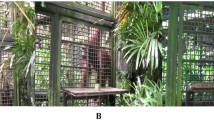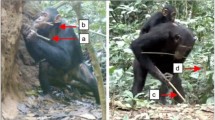Abstract
Great apes can use multiple tools to extract food embedded in substrates and can invent new ways to exploit those resources. We tested five bonobos, five chimpanzees, and six orangutans in a task in which they had to use (and modify) a tool as a straw to drink the juice located inside a container. Experiment 1 showed that four orangutans and one chimpanzee invented the use of a piece of electric cable to get the juice. Experiment 2 investigated whether subjects could transform a non-functional hose into a functional one by removing blockages that impeded the free flow of juice. Orangutans outperformed chimpanzees and bonobos by differentially removing those blockages that prevented the flow of juice, often doing so before attempting to extract the juice. In Experiment 3, we presented chimpanzees and orangutans with four 3-tool sets (each tool set contained a single straw-like tool) and allowed them to select one tool. Unlike chimpanzees, orangutans succeeded in selecting the straw-like tool above chance levels without having to physically manipulate it. We suggest that orangutans’ superior performance is related to their greater reliance on mouth actions during foraging. Experiment 4 investigated whether orangutans were also capable of selecting the suitable tool not by its appearance, but by the effects that it produced. After witnessing the experimenter blow bubbles or absorb liquid with a functional tool but fail to accomplish the same thing with the non-functional tool, orangutans failed to select the functional tool above chance levels.



Similar content being viewed by others
References
Beck BB (1980) Animal tool behavior: the use and manufacture of tools by animals. Garland, New York
Bird CD, Emery NJ (2009) Insightful problem solving and creative tool modification by captive non tool-using rooks. Proc Natl Acad Sci USA 106:10370–10375
Chappell J, Kacelnik A (2002) Tool Selectivity in a Non-Primate, the New Caledonian Crow (Corvus moneduloides). Anim Cogn 5:71–78
Chappell J, Kacelnik A (2004) Selection of tool diameter by New Caledonian Crows Corvus moneduloides. Anim Cogn 7:121–127
Fox EA, Sitompul AF, van Schaik CP (1999) Intelligent tool use in wild Sumatran orangutans. In: Parker ST, Miles HL, Mitchell RW (eds) The mentality of Gorillas and Orangutans. Cambridge University Press, Cambridge, pp 99–116
Girndt A, Meier T, Call J (2008) Task constraints Mask Great Apes’ ability to solve the trap-table task. J Exp Psychol Anim Behav Process 34:54–62
Hart BL, Hart LA, McCoy M, Sarath CR (2001) Cognitive behaviour in asian elephants: use and modification of branches for fly switching. Anim Behav 62:839–847
Hunt GR, Gray RD (2004) The crafting of hook tools by wild new Caledonian Crows. Proc R Soc Lon B Suppl 271:S88–S90
Lefebvre L, Whittle P, Lascaris E, Finkelstein A (1997) Feeding innovations and forebrain size in birds. Anim Behav 53:549–560
Manrique HM, Gross A, Call J (2010) Great apes select tools on the basis of their rigidity. J Exp Psychol Anim Behav Process 36(4):409–422
Martin-Ordas G, Call J (2009) Assessing generalization within and between trap tasks in the great apes. Int J Comp Psychol 22:43–60
Martin-Ordas G, Call J, Colmenares F (2008) Tubes, tables and traps: great apes solve two functionally equivalent trap tasks but show no evidence of transfer across tasks. Anim Cogn 11:423–430
McGrew WC (1992) Chimpanzee material culture: implications for human evolution. Cambridge University Press, Cambridge
Mendes N, Hanus D, Call J (2007) Raising the level: orangutans use water as a tool. Biol Lett 3:453–455
Mulcahy NJ, Call J (2006a) Apes save tools for future use. Science 312:1038–1040
Mulcahy NJ, Call J (2006b) How great apes perform on a modified trap-tube task. Anim Cogn 9:193–199
Mulcahy NJ, Call J, Dunbar RIM (2005) Gorillas (Gorilla gorilla) and Orangutans (Pongo pygmaeus) Encode Relevant Problem Features in a Tool-Using Task. J Comp Psychol 119:23–32
O’Malley RC, McGrew WC (2000) Oral tool use by captive orangutans (Pongo pygmaeus). Folia Primatol 71:334–341
Osvath M, Osvath H (2008) Chimpanzee (Pan troglodytes) and orangutan (Pongo abelii) forethought: self-control and pre-experience in the face of future tool use. Anim Cogn 11:661–674
Reader SM, Laland KM (2002) Social intelligence, innovation and enhanced brain size in primates. Proc Natl Acad Sci USA 99:4436–4441
Sanz C, Call J, Morgan D (2009) Design complexity in termite-fishing tools of chimpanzees (Pan troglodytes). Biol Lett 5:293–296
Sol D, Timmermans S, Lefebvre L (2002) Behavioural flexibility and invasion success in birds. Anim Behav 63:495–502
Tebbich S, Bshary R (2004) Cognitive abilities related to tool use in the Woodpecker Finch, Cactospiza pallida. Anim Behav 67:689–697
Tomasello M, Call J (1997) Primate cognition. Oxford University Press, New York
van Schaik CP, Knott CD (2001) Geographic variation in tool use on Neesia fruits in orangutans. Am J Phys Anthrop 114:331–342
Visalberghi E, Addessi E, Truppa V, Spagnoletti N, Ottoni E, Izar P, Fragaszy D (2009) Selection of effective stone tools by wild bearded capuchin monkeys. Curr Biol 19:213–217
Acknowledgments
Héctor Marín Manrique was supported by a postdoctoral contract funded by the Spanish “Programa de Ayuda a la Movilidad del Ministerio de Ciencia e Innovacion (Micinn)”.
Author information
Authors and Affiliations
Corresponding author
Rights and permissions
About this article
Cite this article
Manrique, H.M., Call, J. Spontaneous use of tools as straws in great apes. Anim Cogn 14, 213–226 (2011). https://doi.org/10.1007/s10071-010-0355-4
Received:
Revised:
Accepted:
Published:
Issue Date:
DOI: https://doi.org/10.1007/s10071-010-0355-4




